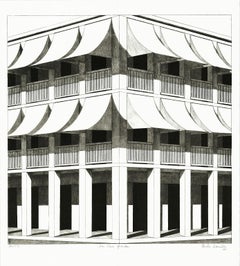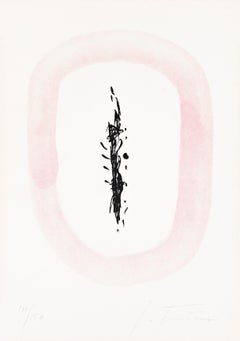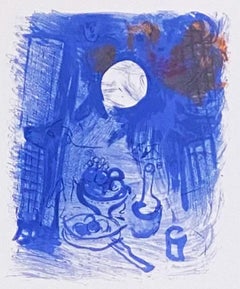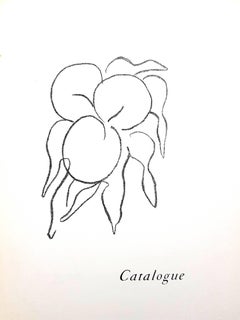Lithograph More Prints
to
126
247
147
175
47
33
Overall Width
to
Overall Height
to
649
468
344
314
93
72
56
41
19
14
7
3
1
1
153
45
43
20
12
5
640
4
15
4
25
78
111
180
109
14
15
533
105
4
38
25
25
23
13
12
12
11
10
8
6
5
5
4
4
4
3
3
3
2
649
87
62
62
45
58
85
398
244
Style: Modern
Medium: Lithograph
La Casa Grande
Located in New York, NY
“LA CASA GRANDE”
Emilio Sanchez (1921-1999) created this lithograph entitled “La Casa Grande” in 1997. The printed image size is 30.5 x 30 inches and ...
Category
Late 20th Century American Modern Lithograph More Prints
Materials
Lithograph
Senza titolo (Concetto Spaziale)
Located in New York, NY
A very good impression of this color photolithograph with strong colors on Magnani Pescia paper. Signed and numbered 101/150 in pencil by Fontana. Printed by Le Arte Grafiche Pardini...
Category
1960s Modern Lithograph More Prints
Materials
Color, Lithograph
Blue Still Life
By Marc Chagall
Located in Washington, DC
Artist: Marc Chagall
Title: Blue Still Life
Portfolio: Derriere le Miroir 99-100
Medium: Lithograph
Date: 1957
Edition: 2500
Frame Size: 19 1/2" x 17 3/4"
Sheet Size: 15" x 11"
Signa...
Category
1950s Modern Lithograph More Prints
Materials
Lithograph
Still Life with Fish and jugs
Located in San Francisco, CA
This artwork titled "Still Life with Fish and Jugs" 1966, is an original colors lithograph on Japan nacre paper by renown Russian artist Mihail Chemiakin, b.1943. It is hand signed a...
Category
Late 20th Century Modern Lithograph More Prints
Materials
Lithograph
Jean Cocteau - Portrait - Original Lithograph
By Jean Cocteau
Located in Collonge Bellerive, Geneve, CH
Original Lithograph by Jean Cocteau
Title: Taureaux
Signed in the plate
Dimensions: 40 x 30 cm
Edition: 200
Luxury print edition from the portfolio of Trinckvel
1965
From the last po...
Category
1960s Modern Lithograph More Prints
Materials
Lithograph
Henri Matisse - Fruits - Original Lithograph
Located in Collonge Bellerive, Geneve, CH
Henri Matisse - Fruits - Original Lithograph
1964
Dimensions: 30 x 20 cm
Edition of 200 (one of the 200 on Vélin de Rives)
Mourlot Press, 1964
Unsigned and unumbered as issued
Category
1960s Modern Lithograph More Prints
Materials
Lithograph
Le Coq, from Verve Vol VII No. 27-28
Located in Washington, DC
Artist: Georges Braque
Title: Le Coq
Portfolio: Verve Vol VII No. 27-28
Medium: Lithograph
Date: 1952
Edition: 6000
Frame Size: 22" x 18 1/4"
Sheet Size: 14" x 10"
Signature: Unsigned
Category
1950s Modern Lithograph More Prints
Materials
Lithograph
Tours & Excursions Original Coach Travel Poster Mid Century Modern British
Located in London, GB
Anonymous
Tours and Excursions
Original Coach Poster
75x50cm
Cool and crazy mid-century lettering. Poster with area for completion with details ...
Category
1960s Modern Lithograph More Prints
Materials
Lithograph
1943 Junkers Ju87 Stuka Dive Bomber Luftwaffe US aeroplane recognition poster
Located in London, GB
To see our other original vintage propaganda posters, scroll down to "More from this Seller" and below it click on "See all from this Seller" - or send us a message if you cannot fin...
Category
1940s Modern Lithograph More Prints
Materials
Lithograph
Vintage Russian Shtetl Scene, Judaica Lithograph
Located in Surfside, FL
Pencil signed and dated, colored Judaica Lithograph.
Anatoli Lwowitch Kaplan was a Russian painter, sculptor and printmaker, whose works often reflect his Jewish origins.
His father...
Category
Mid-20th Century Modern Lithograph More Prints
Materials
Lithograph
Original Cote de Atlantiques - Chemins de fer Francais vintage travel poster
Located in Spokane, WA
Côte de l’Atlantique, Chemins de fer Français vintage SNCF travel poster - Gaston Larrieu, 1971.
Original Authentic Vintage Travel Poster — Linen-Backed. Very good condition, ready ...
Category
1970s American Modern Lithograph More Prints
Materials
Lithograph
1943 Vultee Vengeance World War 2 aeroplane recognition poster pub. US Navy RAF
Located in London, GB
To see our other original vintage propaganda posters, scroll down to "More from this Seller" and below it click on "See all from this Seller" - or send us a message if you cannot fin...
Category
1940s Modern Lithograph More Prints
Materials
Lithograph
Paul Jenkins - Composition - Original Lithograph
By Paul Jenkins
Located in Collonge Bellerive, Geneve, CH
Paul Jenkins - Composition - Original Lithograph
1964
Dimensions: 30 x 20 cm
Edition of 200 (one of the 200 on Vélin de Rives)
Mourlot Press, 1964
Paul Jenkins, American (1923 - 2012)
Paul Jenkins, an artist originally associated with abstract expressionism, exhibits in his mature works a redefining of color, light and space on the canvas surface.
Born in Kansas City, Missouri in 1923, Jenkins worked as a teenager in a ceramics factory, where he was first exposed to color intensity and the creation of form. From age 14 to 18, he studied drawing and painting at the city's Art Institute.
Initially interested in drama, Jenkins received a fellowship to the Cleveland Playhouse, then continued his dramatic studies in Pittsburgh at the Drama School of the Carnegie Institute of Technology.
Deciding to become an artist, Jenkins moved to New York City in 1948 and studied at the Art Students League. During Jenkins's three years at the League, Yasuo Kuniyoshi and Morris Kantor were his influential instructors.
While Jenkins continued to live and paint in New York City, his personal explorations took a metaphysical turn, which would ultimately become dominant in his work.
P.D. Ouspensky's The Search of the Miracu/ous changed the artist's thoughts on human growth and limitations, while the Chinese I Ching, through its thematic emphasis on constant change, heightened his interest in flowing paint on canvas. Painting for Jenkins became an intuitive, almost mystical process. He commented, "I paint what God is to me."
In 1953, Jenkins traveled to Paris, where, a year later, he had his first one-man show. While working at the American Artists Center, he continued to experiment with flowing paints, pouring pigment in streams of various thicknesses, with white thin spills as linear overlays.
Jenkins's intent was to deny stasis and create a literal and metaphysical sense of dynamism, while maintaining a sense of unity. Beginning in 1958, Jenkins titled each canvas Phenomena, with additional identifying words. He believed the work to be descriptive of the discovery process inherent in each painting.
Paralleling his beliefs, the artist's paintings have undergone subtle but definite changes. Beginning in the early 1 960s, a shift of color saturation and exposure of the white areas gave Jenkins's canvases an enhanced feeling of illumination.
If Jenkins's technique is unorthodox, he is in many other ways a traditional artist. He works in an acrylic medium on traditional linen canvas or fine rag paper. Often he uses an ivory knife...
Category
1960s Modern Lithograph More Prints
Materials
Lithograph
1942 Royal Air Force Bristol Beaufighter aeroplane recognition poster World War
Located in London, GB
To see our other original vintage propaganda posters, scroll down to "More from this Seller" and below it click on "See all from this Seller" - or send us a message if you cannot fin...
Category
1940s Modern Lithograph More Prints
Materials
Lithograph
Original Owl and Pussy Cat - Greek theater poster
Located in Spokane, WA
Original The Owl And The Pussycat, by Edward Lear with all text in Greek.
Linen backed and in very good condition. One tiny printing flaw under the foot of the cat.
Translation:...
Category
1960s American Modern Lithograph More Prints
Materials
Lithograph
Berlin 1955 Poster Kurfürstendamm Berlin Night Kaiser Wilhelm Gedächtniskirche
Located in London, GB
To see our other original vintage travel posters, scroll down to "More from this Seller" and below it click on "See all from this Seller" - or send us a message if you cannot find the poster you want.
Berlin - Kaiser Wilhelm...
Category
1950s Modern Lithograph More Prints
Materials
Lithograph
1943 Grumman F6F Hellcat World War 2 aeroplane warbird poster pub. US Navy
Located in London, GB
To see our other original vintage propaganda posters, scroll down to "More from this Seller" and below it click on "See all from this Seller" - or send us a message if you cannot find the poster you want.
US Naval Aviation Training Division
Grumman F6F Hellcat...
Category
1940s Modern Lithograph More Prints
Materials
Lithograph
Rachel Hides Her Father's Household Goods, from 1960 Drawings for the Bible
By Marc Chagall
Located in Washington, DC
Artist: Marc Chagall
Title: Rachel Hides Her Father's Household Goods
Portfolio: Drawings for the Bible
Medium: Lithograph
Year: 1960
Edition: Unnumbered
Frame Size: 22 1/4" x 18 3/4...
Category
1960s Modern Lithograph More Prints
Materials
Lithograph
Hotel Finlandia Punkaharju Suomi Finland Original Vintage Luggage Label
Located in London, GB
To see our other original vintage travel posters, scroll down to "More from this Seller" and below it click on "See all from this Seller" - or send us a message if you cannot find the poster you want.
Hotel Finlandia Punkaharju Suomi Finland...
Category
Mid-20th Century Modern Lithograph More Prints
Materials
Lithograph
London Transport 1935 Poster Early in the Month Clifford and Rosemary Ellis
Located in London, GB
To see our other original vintage travel posters including more pre-war London Transport posters, scroll down to "More from this Seller" and below it click on "See all from this Seller" - or send us a message if you cannot find the poster you want.
Clifford and Rosemary Ellis...
Category
1930s Modern Lithograph More Prints
Materials
Lithograph
Atelier Mourlot - New York (NYC Skyline) by Bernard Buffet
Located in New York, NY
Arches Poster Paper - Perfect Condition A+
When The Mourlot Studio opened a branch in New York City, after a successful exhibition organized by the Smithsonian Institute in 1963, it...
Category
1960s Modern Lithograph More Prints
Materials
Lithograph
Jean Cocteau - Bulls - Original Lithograph
By Jean Cocteau
Located in Collonge Bellerive, Geneve, CH
Original Lithograph by Jean Cocteau
Title: Taureaux
Signed in the plate
Dimensions: 40 x 30 cm
Edition: 200
Luxury print edition from the portfolio of Trinckvel
1965
Jean Cocteau
W...
Category
1960s Modern Lithograph More Prints
Materials
Lithograph
Original 1930s Bieres D'Aubel, Rien de Tel! vintage beer poster, linen-backed
Located in Spokane, WA
Original poster: Bieres D' Aubel. Artist Odette Servais. Size: 21" x 28.5". Original vintage French beer poster. Archival linen-backed and ready to frame. Excellent condition. It was...
Category
1930s American Modern Lithograph More Prints
Materials
Lithograph
Jean Cocteau - Portrait - Original Lithograph
By Jean Cocteau
Located in Collonge Bellerive, Geneve, CH
Original Lithograph by Jean Cocteau
Title: Taureaux
Signed in the plate
Dimensions: 40 x 30 cm
Edition: 200
Luxury print edition from the portfolio of Trinckvel
1965
Jean Cocteau
W...
Category
1960s Modern Lithograph More Prints
Materials
Lithograph
Bathers
Located in OPOLE, PL
Pablo Picasso (1881-1973) - Bathers
Lithograph from 1946.
Dimensions of work: 32,8 x 48 cm
Publisher: Pantheon.
The work is in Excellent condition.
Fast and secure shipment.
Category
1940s Modern Lithograph More Prints
Materials
Lithograph
$929 Sale Price
20% Off
Le Corbusier: "Le Poème de L'Angle Droit". Original lithograph.
By Le Corbusier
Located in Richmond, GB
Charles-Éduard Jeanneret, known as Le Corbusier, was a Swiss architect and designer who is generally regarded as a key figure in the development of modern architecture, his work bein...
Category
Mid-20th Century Modern Lithograph More Prints
Materials
Lithograph
London Underground Map of London Christmas poster by Clifford and Rosemary Ellis
Located in London, GB
To see our other original vintage travel posters including more pre-war London Transport posters, scroll down to "More from this Seller" and below it click on "See all from this Seller" - or send us a message if you cannot find the poster you want.
Clifford and Rosemary Ellis
London Underground Map...
Category
1930s Modern Lithograph More Prints
Materials
Lithograph
French Renaissance - Lithograph - 19th Century
Located in Roma, IT
French Renaissance is an artwork realized in 19th century.
Lithograph on paper.
The artwork represents decorative patterns of French Renaissance Architecture. The artwork is depict...
Category
19th Century Modern Lithograph More Prints
Materials
Lithograph
Le Corbusier: "Le Poème de L'Angle Droit". Original lithograph.
By Le Corbusier
Located in Richmond, GB
Charles-Éduard Jeanneret, known as Le Corbusier, was a Swiss architect and designer who is generally regarded as a key figure in the development of modern architecture, his work bein...
Category
Mid-20th Century Modern Lithograph More Prints
Materials
Lithograph
Jean Cocteau - Bulls - Original Lithograph
By Jean Cocteau
Located in Collonge Bellerive, Geneve, CH
Original Lithograph by Jean Cocteau
Title: Taureaux
Signed in the plate
Dimensions: 40 x 30 cm
Edition: 200
Luxury print edition from the portfolio of Trinckvel
1965
Jean Cocteau
W...
Category
1960s Modern Lithograph More Prints
Materials
Lithograph
Jean Cocteau - Bulls - Original Lithograph
By Jean Cocteau
Located in Collonge Bellerive, Geneve, CH
Original Lithograph by Jean Cocteau
Title: Taureaux
Signed in the plate
Dimensions: 40 x 30 cm
Edition: 200
Luxury print edition from the portfolio of Trinckvel
1965
From the last po...
Category
1960s Modern Lithograph More Prints
Materials
Lithograph
Jean Cocteau - Surrealist Torrero - Original Lithograph
By Jean Cocteau
Located in Collonge Bellerive, Geneve, CH
Original Lithograph by Jean Cocteau
Title: Taureaux
Signed in the plate
Dimensions: 40 x 30 cm
Edition: 200
Luxury print edition from the portfolio of Trinckvel
1965
From the last po...
Category
1960s Modern Lithograph More Prints
Materials
Lithograph
Jean Cocteau - Profile - Original Lithograph
By Jean Cocteau
Located in Collonge Bellerive, Geneve, CH
Original Lithograph by Jean Cocteau
Title: Taureaux
Signed in the plate
Dimensions: 40 x 30 cm
Edition: 200
Luxury print edition from the portfolio of Trinckvel
1965
Jean Cocteau
W...
Category
1960s Modern Lithograph More Prints
Materials
Lithograph
Vallauris
Located in OPOLE, PL
Pablo Picasso (1881-1973) - Vallauris
Lithograph from 1954.
Dimensions of work: 35.5 x 26.5 cm
Publisher: Tériade, Paris.
The work is in Excellent condition.
Fast and secure shi...
Category
1950s Modern Lithograph More Prints
Materials
Lithograph
Portrait of Valery Panov
Located in San Francisco, CA
This artwork titled "Portrait of Valery Panov" c.1979, is an original colors lithograph on Wove paper by renown Russian artist Mihail Chemiakin, b.1943. It is hand signed and inscrib...
Category
Late 20th Century Modern Lithograph More Prints
Materials
Lithograph
Black Blush
Located in New York, NY
A very good, richly-inked impression of this large, scarce print. Hand-painted carborundum relief (hand-painted in Permanent Maroon and Prussian Blue Hue, then printed in Titanium Wh...
Category
2010s Modern Lithograph More Prints
Materials
Paint, Color, Lithograph
Jean Cocteau - The Arena - Original Lithograph
By Jean Cocteau
Located in Collonge Bellerive, Geneve, CH
Original Lithograph by Jean Cocteau
Title: The Arena
1961
Dimensions: 38 x 28 cm
printed signature
Lithograph made for the portfolio "Gitans et Corridas" published by Socié...
Category
1960s Modern Lithograph More Prints
Materials
Lithograph
Hommage à San Lazzaro
By Max Bill
Located in OPOLE, PL
Max Bill (1908-1994) - Hommage à San Lazzaro
Lithograph from 1975.
Edition 371/575 (Photocopy of the colophone is included).
Dimensions of work: 31 x 24 cm.
Each copy of this lit...
Category
1970s Modern Lithograph More Prints
Materials
Lithograph
$657 Sale Price
20% Off
Barbados Children.
Located in New York, NY
Emilio Sanchez (1921-1999) created this color lithograph entitled “Barbados Children” in 1996. This signed impression came to us directly from the Sanchez estate. Estate stamped on v...
Category
Late 20th Century American Modern Lithograph More Prints
Materials
Lithograph
Profile and Red Child, from 1960 Mourlot Lithographe I
By Marc Chagall
Located in Washington, DC
Artist: Marc Chagall
Title: Profile and Red Child
Portfolio: Mourlot Lithographe I
Medium: Lithograph
Year: 1960
Edition: Unnumbered
Framed Size: 21 7/8" x 18 7/8"
Image Size: 12 1/2...
Category
1960s Modern Lithograph More Prints
Materials
Lithograph
Jean Cocteau - Portrait - Original Lithograph
By Jean Cocteau
Located in Collonge Bellerive, Geneve, CH
Original Lithograph by Jean Cocteau
Title: Taureaux
Signed in the plate
Dimensions: 40 x 30 cm
Edition: 200
Luxury print edition from the portfolio of Trinckvel
1965
Jean Cocteau
W...
Category
1960s Modern Lithograph More Prints
Materials
Lithograph
Jean Cocteau - Fire Portrait - Original Lithograph
By Jean Cocteau
Located in Collonge Bellerive, Geneve, CH
Original Lithograph by Jean Cocteau
Title: Taureaux
Signed in the plate
Dimensions: 40 x 30 cm
Edition: 200
Luxury print edition from the portfolio of Trinckvel
1965
Jean Cocteau
W...
Category
1960s Modern Lithograph More Prints
Materials
Lithograph
French and German Renaissance - Lithograph - 19th Century
Located in Roma, IT
French and German Renaissance is an artwork realized in 19th century.
Lithograph on paper.
The artwork represents decorative patterns of French and German Renaissance Architecture....
Category
19th Century Modern Lithograph More Prints
Materials
Lithograph
Jean Cocteau - Bull Portrait - Original Lithograph
By Jean Cocteau
Located in Collonge Bellerive, Geneve, CH
Original Lithograph by Jean Cocteau
Title: Taureaux
Signed in the plate
Dimensions: 40 x 30 cm
Edition: 200
Luxury print edition from the portfolio of Trinckvel
1965
Jean Cocteau
W...
Category
1960s Modern Lithograph More Prints
Materials
Lithograph
Jean Cocteau - Colorful Portrait - Original Lithograph
By Jean Cocteau
Located in Collonge Bellerive, Geneve, CH
Original Lithograph by Jean Cocteau
Title: Taureaux
Dimensions: 40 x 30 cm
Edition: 200
Luxury print edition from the portfolio of Trinckvel
1965
Jean Cocteau
Writer, artist and fi...
Category
1960s Modern Lithograph More Prints
Materials
Lithograph
Le Peintre et son Modèle II
Located in OPOLE, PL
Pablo Picasso (1881-1973) - Le Peintre et son Modèle II
Lithograph from 1954.
Dimensions of work: 35.5 x 26.5 cm
Publisher: Tériade, Paris.
The work is in Excellent condition.
F...
Category
1950s Modern Lithograph More Prints
Materials
Lithograph
Jean Cocteau - Hero - Original Lithograph
By Jean Cocteau
Located in Collonge Bellerive, Geneve, CH
Original Lithograph by Jean Cocteau
Title: Taureaux
Signed in the plate
Dimensions: 40 x 60 cm
Edition: 200
Luxury print edition from the portfolio of Trinckvel
1965
Jean Cocteau
W...
Category
1960s Modern Lithograph More Prints
Materials
Lithograph
"Homage to Nureyev" large lithograph
Located in San Francisco, CA
This artwork titled "Homage to Nureyev" c.1993, is an original colors lithograph on wove paper by renown Russian artist Mihail Chemiakin, b.1943. It is hand signed and numbered 48/17...
Category
Late 20th Century Modern Lithograph More Prints
Materials
Lithograph
Princesse d'Azur
By Jean Carzou
Located in OPOLE, PL
Jean Carzou (1907-2000) - Princesse d'Azur
Lithograph from 1976.
Dedicated to Charles Sorlier, on Arches paper.
Dimensions of work: 78 x 54.5 cm.
Hand signed.
The work is in Goo...
Category
1970s Modern Lithograph More Prints
Materials
Lithograph
Le vieux Roi
Located in OPOLE, PL
This work will be exhibited at Art on Paper NYC, September 4–7, 2025.
–
Pablo Picasso (1881–1973) – Le Vieux Roi (Old King)
Technique: Original lithograph
Year: 1959
Dimensions: 64...
Category
1950s Modern Lithograph More Prints
Materials
Lithograph
Blind Botanist
By Ben Shahn
Located in New York, NY
This 1963 lithograph, printed in color, is a fine example of Ben Shahn’s long preoccupation with the theme of the blind botanist and illustrates his con...
Category
Late 20th Century Modern Lithograph More Prints
Materials
Lithograph
Vintage Russian Shtetl Scene, Judaica Lithograph
Located in Surfside, FL
Pencil signed and dated, colored Judaica Lithograph.
Anatoli Lwowitch Kaplan was a Russian painter, sculptor and printmaker, whose works often reflect his Jewish origins.
his father...
Category
Mid-20th Century Modern Lithograph More Prints
Materials
Lithograph
Jean Cocteau - Portrait - Original Lithograph
By Jean Cocteau
Located in Collonge Bellerive, Geneve, CH
Original Lithograph by Jean Cocteau
Title: Taureaux
Signed in the plate
Dimensions: 40 x 30 cm
Edition: 200
Luxury print edition from the portfolio of Trinckvel
1965
Jean Cocteau
W...
Category
1960s Modern Lithograph More Prints
Materials
Lithograph
Pedro Casals San Juan Puerto Rico vintage poster
Located in Wilton Manors, FL
Lorenzo Homar
Casals Poster, 1966.
Lithograph, 19 x 29 inches.
Some wear as can be observed in detail photos.
Category
Mid-20th Century Modern Lithograph More Prints
Materials
Lithograph
The Taste of Happiness, Planche L
Located in OPOLE, PL
Pablo Picasso (1881-1973) - The Taste of Happiness, Planche L
Lithograph from 1970.
An unsigned and unnumbered edition of 666.
Dimensions of sheet: 32.5 x 25 cm
Dimensions in fra...
Category
1970s Modern Lithograph More Prints
Materials
Lithograph
Marc Chagall - The Bible - Sarah And Abimelech - Original Lithograph
By Marc Chagall
Located in Collonge Bellerive, Geneve, CH
Marc Chagall, Original Lithograh depicting an instant of the Bible.
Technique: Original lithograph in colours (Mourlot no. 234)
On the reverse: another black and white original litho...
Category
1960s Modern Lithograph More Prints
Materials
Lithograph
The Divine Word
Located in OPOLE, PL
Salvador Dali (1904-1989) - The Divine Word
Lithograph from 1973.
Editon 101/250 on Arches paper.
Dimensions of work: 65 x 48 cm
Publisher: Carpentier.
Reference: Michler-Löpsin...
Category
1970s Modern Lithograph More Prints
Materials
Lithograph
$2,535 Sale Price
42% Off
'Fougasse', Careless Talk Costs Lives World War 2 poster
Located in London, GB
Cyril Kenneth Bird ‘Fougasse’ (1887 - 1965)
Careless Talk Costs Lives (circa 1940)
Set of eight lithographic posters
32 x 20 cm each
"Strictly between you and me.." ; "..but for Hea...
Category
1940s Modern Lithograph More Prints
Materials
Lithograph
"Cage/Cunningham, " Film by Elliot Caplan
Located in New York, NY
Gary Lichtenstein
"Cage/Cunningham," Film by Elliot Caplan, 1991
Lithograph poster
49 1/2 x 38 inches
Edition 9 of 75, with 25
Signed by Merce Cunnin...
Category
Late 20th Century Modern Lithograph More Prints
Materials
Lithograph, Offset
Philip Guston "Studio Corner" Lithograph, Brooke Alexander Gallery
Located in Lake Worth Beach, FL
Artist/Designer; Manufacturer: Philip Guston (1913-1980)
Marking(s); notes: signed, blind stamp; ed. 39/50; 1980
Country of origin; materials: Canadian-American; lithograph
Dimension...
Category
1980s Modern Lithograph More Prints
Materials
Lithograph
Lithograph more prints for sale on 1stDibs.
Find a wide variety of authentic Lithograph more prints available on 1stDibs. While artists have worked in this medium across a range of time periods, art made with this material during the 21st Century is especially popular. If you’re looking to add more prints created with this material to introduce a provocative pop of color and texture to an otherwise neutral space in your home, the works available on 1stDibs include elements of blue, orange, purple, yellow and other colors. There are many well-known artists whose body of work includes ceramic sculptures. Popular artists on 1stDibs associated with pieces like this include David Shrigley, Jean Cocteau, Marc Chagall, and David Roberts. Frequently made by artists working in the Contemporary, Modern, all of these pieces for sale are unique and many will draw the attention of guests in your home. Not every interior allows for large Lithograph more prints, so small editions measuring 0.04 inches across are also available Prices for more prints made by famous or emerging artists can differ depending on medium, time period and other attributes. On 1stDibs, the price for these items starts at $44 and tops out at $225,000, while the average work can sell for $956.
Recently Viewed
View AllMore Ways To Browse
Ewan David Eason
Florida Vintage Travel Posters
Goodyear Poster
Gustav Klutsis
Ihap Hulusi
Ivan Navarro
James B Painter
James Bond Movie Posters
Jan V Roy Posters
John Lennon On Sale
Lait Pur Sterilize
Lake District Vintage Travel Poster
Land Rover Poster
Le Frou Frou Vintage Poster
Leon De Pas
Leon Wuidar
Lillian Snelling
Man Ray Electro Magie



